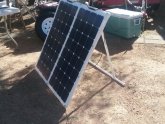svetz
Works in theory! Practice? That's something else
While posting in @Kathymel's thread Upgrading system thread I advised her not to use Flexible panels.
But I had to eat my words and wanted to repost here to make it more visible ... take a look at the current Renogy warranty (click the link, scroll down, then click the Specification tab) for their flexible panels, it sure looks like the technology has come of age:
100W for 4.2 lbs that could be glued down somewhere and is 21% efficient at $1.89/W?
This paves the way for a few more solar projects....We sure do live in interesting times! What sort of projects could you do with cheap long life flexible panels?
But I had to eat my words and wanted to repost here to make it more visible ... take a look at the current Renogy warranty (click the link, scroll down, then click the Specification tab) for their flexible panels, it sure looks like the technology has come of age:
25-year power output warranty: 5 year/95% efficiency rate, 10 year/90% efficiency rate, 25-year/80% efficiency rate
5-year material and workmanship warranty
100W for 4.2 lbs that could be glued down somewhere and is 21% efficient at $1.89/W?
This paves the way for a few more solar projects....We sure do live in interesting times! What sort of projects could you do with cheap long life flexible panels?
Last edited:





